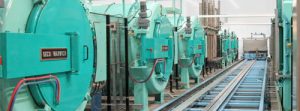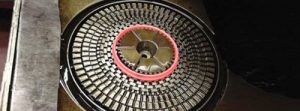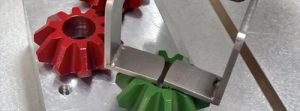
In this column, I will discuss the formation of Widmanstätten ferrite from austenite in steel. This microstructure has a unique appearance and shares some characteristics of bainite.
Introduction
Widmanstätten ferrite, αW, is an interesting type of ferrite that is different in appearance from traditional ferrite. In traditional ferrite, the shape of the microstructure is usually polygonal. Acicular ferrite is needle-shaped and typically forms at the center of the austenite grain, nucleating at inclusions. Widmanstätten ferrite, first observed in meteorites, shows a feathery appearance, initiating along austenite grain boundaries (Figure 1).
The characteristic parallel needles of Widmanstätten ferrite are a result of a specific crystallographic orientation with relationship to the austenite grain. In general, all the needles within a given packet share the same crystallographic orientation. The interface between the αw plate and the austenite is often a low-energy, semi-coherent interface known as the habit plane, which is close to the {558}γ orientation [1] [2].

As the Widmanstätten plate grows, the shape of the transformed region changes, and is characteristic of a displacive transformation [2]. Because the mechanism of Widmanstätten plate formation is displacive in nature — meaning that the atomic correspondence between the parent face-centered cubic structure of austenite, and the body-centered cubic ferrite is maintained — carbon must partition into the surrounding austenite during growth of the plate [3]. However, this does not occur in isolation. There are other competing transformations occurring, such as the formation of pearlite, or polygonal ferrite [4]. This means that these different transformations can interfere with each other regarding the portioning of carbon, and physical space.
The density, spacing, and distribution of plates depends on the cooling rate, alloy composition (predominantly the carbon and manganese content), and prior austenite grain size. Finer austenite grains and lower cooling rates promote more nucleation sites, yielding finer Widmanstätten ferrite microstructures [5].
In general, large prior austenite grain size tends to encourage Widmanstätten ferrite transformation. Finer grain tends to suppress Widmanstätten ferrite formation and favor polygonal ferrite transformation.
The kinetics of Widmanstätten ferrite transformation are dependent on the transformation temperature and the cooling rate. The transformation to Widmanstätten ferrite occurs at an intermediate temperature, above bainite start temperature but below the polygonal ferrite region.
When looking at a TTT (time-temperature-transformation) diagram, it can be broken into two types of curves — one representing reconstructive and the other representing displacive transformations (Figure 2). This lower temperature C-curve represents the displacive transformations such as bainite and Widmanstätten ferrite.
This lower curve is flat on the top and represents the highest temperature that a displacive transformation can occur. This could either be the bainite start temperature (BS) or the Widmanstätten start temperature (WS) [3].
The time-temperature-transformation (TTT) and continuous cooling transformation (CCT) illustrate an Arrhenius relationship, where slower cooling rates through the transformation region (just below Ae3 or the upper transformation temperature of ferrite) produce coarser, more developed Widmanstätten structures [5]. Excessive cooling rates would produce either bainite or martensite.

Widmanstätten ferrite and mechanical properties
In general, as the volume fraction of Widmanstätten ferrite increases, there is a corresponding decrease in fracture toughness, or Charpy impact toughness [6]. It was found that the upper shelf energy (toughness at high temperatures) remained relatively constant, but the ductile-to-brittle transition temperature (DBTT) shifts upward with increasing Widmanstätten fraction. At low Widmanstätten fractions (below about 10 percent), impact toughness was less sensitive, but above this threshold, toughness decreased more sharply with increasing volume fraction.
Coarse Widmanstätten ferrite plates reduce impact toughness by facilitating crack initiation and propagation along plate boundaries; this leads to higher Charpy V-notch transition temperatures, indicating increased brittleness under impact loading. This can also promote cleavage fracture along grain boundaries.
Finer, well-dispersed plates formed under rapid cooling or with refined microstructure, increase impact toughness by disrupting crack paths and promoting energy absorption.
Tensile properties tend to increase as the size of the Widmanstätten ferrite plates decrease, following a Hall-Petch relationship, following an inverse square root of the plate spacing.
Conclusions
In this article, I discussed Widmanstätten ferrite, which forms from austenite at prior austenite grain boundaries in a displacive transformation. Formation is dependent on the cooling rate; too slow cooling rates transforming austenite to polygonal ferrite. Excessive cooling rates can cause the transformation of bainite or martensite.
Should you have any comments regarding this article, or suggestions for additional articles, please contact the editor or myself.
References
- P. H. Shipway and H. Bhadeshia, “The mechanical stabilisation of Widmanstätten ferrite,” Materials Science and Engineering: A, vol. 223, no. 1-2, pp. 179-185, 1997.
- J. D. Watson and P. G. McDougall, “Crystallography of Widmanstätten Ferrite,” Acta Metallurgi-ca, vol. 21, pp. 961-973, 1973.
- S. J. Jones and H. Bhadeshia, “Kinetics of the Widmanstätten Ferrite Transformation in Steels,” in Displacive Phase Transformations and their Applications in Materials Engineering, K. Inoue, K. Mukherjee, K. Otsuka and H. Chen, Eds., Warrendale, PA: The Minerals, Metals and Materials Socie-ty, 1998, pp. 419-426.
- R. L. Bodnar and S. S. Hansen, “Effects of Widmanstätten ferrite on the mechanical properties of steel,” Met. Trans. A, vol. 25A, pp. 763-773, 1994.
- R. Grewal, C. Aranas, K. Chadha, D. Shahriari, M. Jahazi and J. J. Jonas, “Formation of Widmanstätten ferrite at very high temperatures in the austenite phase field,” Acta Materialia, vol. 109, pp. 23-31, 2016.
- H. K. D. H. Bhadeshia, D. J. MacKay and L. E. Svensson, “The Impact Toughness of C–Mn Steel Arc–Welds–A Bayesian Neural Network Analysis,” Materials Science and Technology, vol. 11, pp. 1046-1051, 1995.
- R. Otterberg, R. Sandström and A. Sandberg, “Influence of Widmanstätten ferrite on mechanical properties of microalloyed steels,” Metals Technology, vol. 7B, no. 1, pp. 397-408, 1980.






















